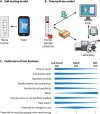At-Home Specimen Self-Collection and Self-Testing for Sexually Transmitted Infection Screening Demand Accelerated by the COVID-19 Pandemic: a Review of Laboratory Implementation Issues
- PMID: 34076475
- PMCID: PMC8525576
- DOI: 10.1128/JCM.02646-20
At-Home Specimen Self-Collection and Self-Testing for Sexually Transmitted Infection Screening Demand Accelerated by the COVID-19 Pandemic: a Review of Laboratory Implementation Issues
Abstract
The coronavirus disease 2019 (COVID-19) pandemic reduced the sexually transmitted infection (STI) testing volume due to social-distancing and stay-at-home orders, among other reasons. These events highlighted previously known benefits of at-home STI self-testing or specimen self-collection and accelerated testing demand via telemedicine. We review testing outside traditional clinical settings. We focus on three curable bacterial STIs among the top 10 U.S. nationally notifiable conditions with screening recommendations: syphilis, gonorrhea (Neisseria gonorrhoeae, also known as the gonococcus [GC]), and chlamydia (Chlamydia trachomatis). At least 19 million GC/C. trachomatis (GC/CT) screening or diagnostic tests are performed annually, presenting a considerable challenge during the pandemic. Unlike for HIV, STI at-home tests are currently not commercially available. However, innovative telemedicine providers currently offer services where specimen self-collection kits are mailed to patients at home who then ship them to laboratories for processing. We discuss technical and regulatory aspects of modifications for home-based specimen self-collection. The telemedicine provider typically manages and communicates results, provides linkage to care, and is responsible for billing and case reporting. We also describe rapid testing devices in development that may present an opportunity for future self-testing. In summary, COVID-19 has accelerated the evaluation and development of STI self-tests and specimen self-collection. The remaining obstacles are high price, regulatory approval, support for laboratories offering the service, and uncertainty regarding whether target populations with the greatest need are reached effectively. However, increased testing, convenience, and privacy are potential benefits that may enhance uptake and outlast the pandemic.
Keywords: laboratory-developed test; rapid test; self-testing; specimen self-collection.
Figures

Similar articles
-
At-home specimen self-collection as an additional testing strategy for chlamydia and gonorrhoea: a systematic literature review and meta-analysis.BMJ Glob Health. 2024 Aug 27;9(8):e015349. doi: 10.1136/bmjgh-2024-015349. BMJ Glob Health. 2024. PMID: 39191483 Free PMC article.
-
Scaling Up CareKit: Lessons Learned from Expansion of a Centralized Home HIV and Sexually Transmitted Infection Testing Program.Sex Transm Dis. 2021 Aug 1;48(8S):S66-S70. doi: 10.1097/OLQ.0000000000001473. Sex Transm Dis. 2021. PMID: 34030160 Free PMC article.
-
Potential impact of the COVID-19 pandemic on the national and regional incidence, epidemiology and diagnostic testing of chlamydia and gonorrhoea in Sweden, 2020.APMIS. 2022 Jan;130(1):34-42. doi: 10.1111/apm.13191. Epub 2021 Nov 25. APMIS. 2022. PMID: 34758169 Free PMC article.
-
Pilot implementation of a home-care programme with chlamydia, gonorrhoea, hepatitis B, and syphilis self-sampling in HIV-positive men who have sex with men.BMC Infect Dis. 2020 Dec 4;20(1):925. doi: 10.1186/s12879-020-05658-4. BMC Infect Dis. 2020. PMID: 33276727 Free PMC article.
-
A Review of the Scope of Direct-to-Consumer Sexually Transmitted Infection Testing Services Offered on the Internet.Sex Transm Dis. 2023 Jun 1;50(6):323-328. doi: 10.1097/OLQ.0000000000001783. Epub 2023 Feb 20. Sex Transm Dis. 2023. PMID: 36807311 Review.
Cited by
-
At-home specimen self-collection as an additional testing strategy for chlamydia and gonorrhoea: a systematic literature review and meta-analysis.BMJ Glob Health. 2024 Aug 27;9(8):e015349. doi: 10.1136/bmjgh-2024-015349. BMJ Glob Health. 2024. PMID: 39191483 Free PMC article.
-
Genital Chlamydia trachomatis Seroprevalence and Uterine Fibroid Development: Cohort Study of Young African-American Women.Microorganisms. 2021 Dec 22;10(1):10. doi: 10.3390/microorganisms10010010. Microorganisms. 2021. PMID: 35056458 Free PMC article.
-
The impact of the National Syphilis Prevention Program on the prevalence of syphilis among people living with HIV in China: a systematic review and meta-analysis.J Int AIDS Soc. 2025 Jan;28(1):e26408. doi: 10.1002/jia2.26408. J Int AIDS Soc. 2025. PMID: 39763073 Free PMC article.
-
Perceptions and Experiences of Returning Self-collected Specimens for HIV, Bacterial STI and Potential PrEP Adherence Testing among Sexual Minority Men in the United States.AIDS Behav. 2023 Apr;27(4):1091-1105. doi: 10.1007/s10461-022-03846-8. Epub 2022 Sep 12. AIDS Behav. 2023. PMID: 36094639 Free PMC article.
-
Study Evaluating Self-Collected Specimen Return for HIV, Bacterial STI, and Potential Pre-Exposure Prophylaxis Adherence Testing Among Sexual Minority Men in the United States.Am J Mens Health. 2022 Jul-Aug;16(4):15579883221115591. doi: 10.1177/15579883221115591. Am J Mens Health. 2022. PMID: 35950608 Free PMC article.
References
-
- National Association of County and City Health Officials. 2019. Issue brief. STI express services: increasing access and testing while maximizing resources. National Association of County and City Health Officials, Washington, DC. https://www.naccho.org/uploads/downloadable-resources/issue-brief_STI-Ex....
-
- Centers for Disease Control and Prevention. 2019. 2018 STD surveillance report. Centers for Disease Control and Prevention, Atlanta, GA. https://www.cdc.gov/nchhstp/newsroom/2019/2018-STD-surveillance-report.h.... Accessed 7 September 2021.
Publication types
MeSH terms
LinkOut - more resources
Full Text Sources
Medical
Miscellaneous

